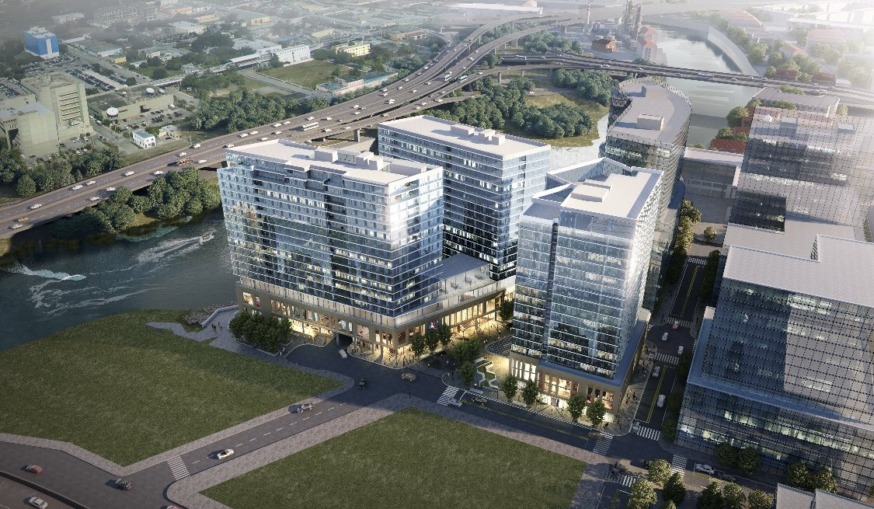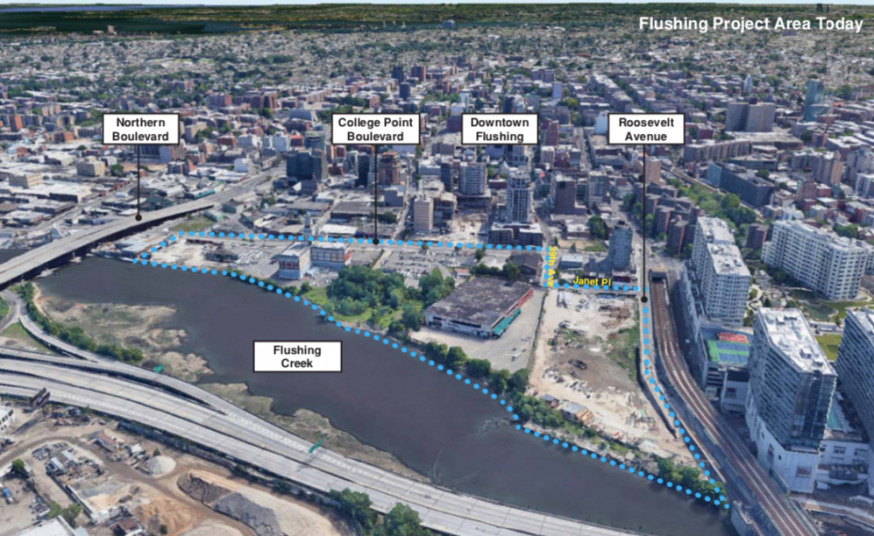
Special Flushing Waterfront District rendering (Courtesy of FWRA)
Dec. 9, 2020 By Allie Griffin
The proposed 13-tower, mixed-use development on the Flushing waterfront is a step closer toward becoming a reality.
The City Council’s Land Use Committee overwhelmingly voted to approve a zoning change that is needed for the ambitious project to move ahead.
The committee voted 14-to-1 to approve the land use application that calls for a 29-acre “Special Flushing Waterfront District.” Only Brooklyn Council Member Inez Barron voted against the project.
The application will go before the full city council for a final vote Thursday. However, now that it has the backing of the Land Use Committee, it is likely that the full council will approve it.
The committee held the vote today, after having negotiated an agreement between the applicant FWRA — a consortium of three developers that each own a portion of the 29 acre district — and union leaders last night.
FWRA reached an agreement with the 32BJ Service Employees International Union and the New York Hotel & Motels Trades Council to provide hundreds of residential, building service and hotel jobs at the project.
The two influential unions had urged the city council to vote against the application prior to the agreement.
“I’m really happy to announce that last night we reached an agreement with labor groups and the applicants that will include union jobs in the Special Flushing Waterfront District with both 32BJ and the Hotel Trades Council,” said Flushing Council Member Peter Koo, who sits on the Land Use committee and voted for the zoning application.
Koo has expressed support for the Flushing project for some time — citing how it would transform the barren industrial land into a publicly accessible waterfront for downtown Flushing. The project would bring 1,725 apartments, multiple hotels, office and retail space as well as a brand new road network and 2.8 acres of public waterfront space.

Dept. of City Planning
Koo’s support is vital, since the council traditionally votes in accordance with the wishes of the member who represents the district where the rezoning is proposed.
The lack of union support had been a stumbling block prior to the union agreement. The limited number of affordable housing units — just 75 to 90 out of 1,725 units – within the proposal was another obstacle several council members took issue with.
However, Koo said FWRA has since agreed to continue talks about adding additional affordable units — though he didn’t provide a specific number.
The developers have agreed to continue conversations with the New York City Department of Housing and Preservation (HPD), which manages the city’s stock of affordable housing, over the next three years, he said.
“Importantly, the applicants have entered into an agreement with the city to further engage in discussions over the next three years with HPD and the Council to work on ways to secure financing so we can maximize the amount of affordable housing on site,” Koo said at the committee meeting.
FWRA’s plans for 75 to 90 affordable units meets the rezoning requirements, but several council members want to see the number increased.
Last month, Council Member Francisco Moya, Chair of the Zoning Subcommittee, and 11 other council members said in a joint statement that they wouldn’t vote to approve the project as it stood at that point – given the lack of union support and the number of affordable units.
Three of the members who signed the statement–Moya and Council Members Diana Ayala and Carlina Rivera – sit on the Land Use committee and voted today to approve the application.
Moya is one of five Queens council members on the committee and all approved it. The others are Koo, Adrienne Adams, Barry Grodenchik, I. Daneek Miller and Antonio Reynoso.
However, Reynoso, who represents parts of Ridgewood, Bushwick and Williamsburg, said in a statement that he had voted for “the lesser of two evils,” saying that what the developers can build as of right is less desirable.
“This is definitely a lesser of two evils vote and I am uncomfortable with it, however the as-of-right scenario is clearly the worse option and I am therefore voting yes on this application,” Reynoso said.
The developers said without the council’s approval of their land use application, they would instead build on the waterfront site as-of-right — and include no affordable housing units and few community benefits.
Reynoso said the project is not a true win for Flushing as it “does absolutely nothing to dig us out of our housing crisis.”
However, the need for well-paying jobs during an economic crisis pushed him to vote yes on the Special Flushing Waterfront District, he said.
The project is estimated to bring in about $116 million in property tax revenue for the city in addition to the hundreds of jobs.
Koo said the revenue will help Flushing’s economy recover.
“As our city comes to terms with a second wave of COVID-19, rising unemployment, and a faltering economy, this project has the potential to revitalize the downtown Flushing economy at a time when we need it most,” he said in a statement. “Our community has suffered long before COVID ever reached our shores. Now is the time to rebuild.”
FWRA has previously said it would break ground on the project as soon as it gets the go-ahead from the city council. The development could be completed as soon as 2025.






